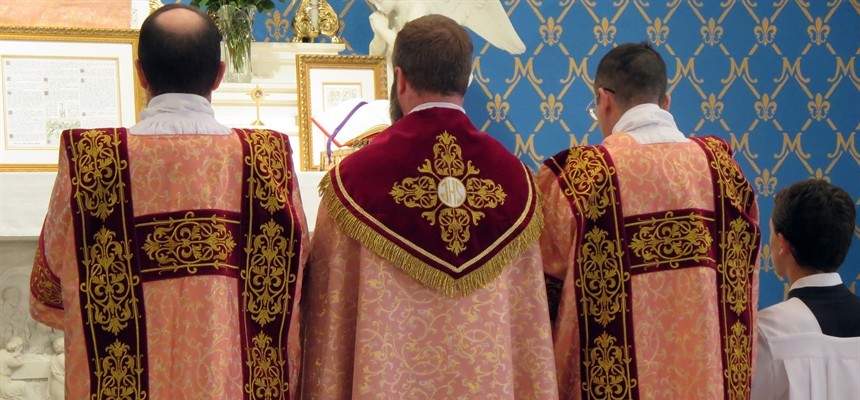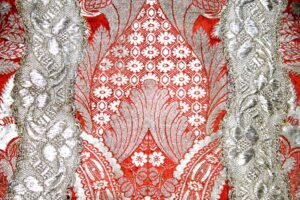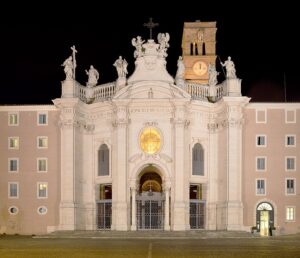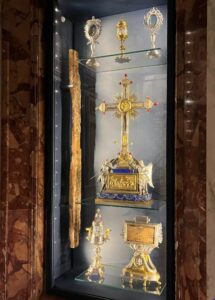10 March 2024
Why Pink? The Lenten Liturgy of Laetare Sunday
By Joey Belleza

Have you ever wondered why pink or rose is used as a liturgical colour for the third Sunday of Advent and fourth Sunday of Lent?
The more popular explanations run something like this: the brightness of rose is meant to “encourage” us to persevere unto the happiness of Christmas and Easter, or simply that pink symbolizes the rejoicing which each Sunday represents, since “gaudete” (3rd Sunday of Advent) and “laetare” (4th Sunday of Lent) both mean “rejoice.”

While these meanings can certainly be drawn as an interpretation of the colour, the historical origin of these vestments is much more fascinating. But first, what exactly is this colour?
In Latin, this shade is called rosacea, meaning “rose-like,” further indicating its relation to the deeper red colour of roses. In a vestment of true rosacea, the base colour of the fabric is actually that vibrant shade of red, like that of rose petals; however, subtle threads of white, gold, or silver are interwoven into the vestment’s embroidered patterns such that from a distance, the hue of red appears lighter. In Rome itself, the redness of rosacea vestments shines through, such that the colour is more like that of a late sunset than the light pink more familiar to us.
The day takes the name laetare (“rejoice!”) from the Introit chant (or “Entrance Antiphon” in today’s parlance) of the Mass. The text of the introit is taken from Isaiah 66:10 and Psalm 22:1, and runs as follows:
Laetare, Jerusalem, et conventum facite omnes qui diligitis eam; gaudete cum laetitia, qui in tristitia fuistis, ut exsultetis, et satiemini ab uberibus consolationis vestrae. Laetatus sum in his quae dicta sunt mihi: in domum Domini ibimus!
Rejoice, Jerusalem, and assemble, all you that love her; rejoice with joy, you who were in sadness, that you may exult be filled from the breasts of your consolation. I rejoiced when they said unto me: let us go to the house of the Lord!
Like it’s analogous counterpart in Advent, Gaudete Sunday (gaudete is another word for “rejoice”; taken from the Introit “Rejoice in the Lord always…”), the mood of the day is festive, a sharp contrast with the sobriety of penitential seasons. Yet this joyfulness shared by both Sundays is not enough to explain why the Church vests herself in rosacea. To understand, we must examine that venerable Lenten tradition called the Roman Stations and delve deep into the history of Christianity.
The Roman Stations are of ancient usage: each “station” is one of Rome’s oldest churches. When Christianity became legal after three centuries of persecution, the Church went on the offensive to counteract the innumerable pagan feasts, often celebrated with large public processions. Christians in Rome developed rival processions to holy sites across the City while singing litanies, and after arriving at a particular “station”, the Pope or one of his senior Cardinals would celebrate Mass at that church. Eventually, the entire season of Lent became like one penitential procession throughout the City, and each day was assigned a station. If one reads older missals or breviaries, one can find the Italian name of the Roman Station (i.e., Santa Maria in Trastevere, San Lorenzo in Panisperna, San Pietro ad Vincula, etc.) under the heading for each day of Lent. In recent years, this practice of Station Masses has been revived, and one of Rome’s auxiliary bishops will lead the stational procession and liturgy of the day.

The Roman Station for Laetare Sunday is Santa Croce in Gerusalemme. This basilica is famous for housing relics of the Passion, including one beam of the Cross (hence the name “Holy Cross”), the spear of Longinus (which pierced the side of Christ), thorns laid on Christ’s head, nails of the crucifixion, and the Title (the inscription “Jesus of Nazareth, King of the Jews” placed over Christ’s head). Before being converted into a church, it was a villa (the ancient Sessorian Palace) owned by Saint Helena (Emperor Constantine’s mother), who made a famous voyage to the Holy Land to find the instruments of the Passion. When she learned that a temple to Venus had been erected on Calvary to prevent Christian devotion, she ordered it demolished, and behold, under the rubble was found the holy relics, just as the local Christians had claimed. In addition to these, she brought back to Rome a big heap of soil from Calvary. Helena then transformed the Sessorian Palace into a shrine for the relics, and laid the soil of Jerusalem under the mosaic floor. Hence the appellation in Gerusalemme: one who steps into this basilica literally steps onto the ground of Jerusalem. To this day, one can venerate the relics of the Passion in this church.

When the Papacy grew in prestige, it became custom for Popes, at their discretion, to send a Golden Rose (a sculpture of a rose fashioned of real gold) to a royal Catholic personage in recognition of his or her patronage and service to the Church. In recent years, Popes have awarded it to persons as well as to papal basilicas of great importance. Historical recipients include Isabella I of Castille (1493), Catherine de’ Medici (1548), the Cathedral of Siena (1658), the Sanctuary of Our Lady at Fatima (1965), and the Shrine of the Immaculate Conception in Washington DC (2008). Often decorated with precious jewels, each Golden Rose is in fact a reliquary containing pieces of the True Cross. The rose was chosen because of its mystical symbolism: Christ is the “flower of the field and the lily of the valleys” (Song of Songs 2:1), while in Isaiah 11:1, the prophecy reads: “There shall come forth a rod out of the root of Jesse, and a flower shall rise up out of his root.” The rose itself, though beautiful and fragrant, still has its thorns. In its image is encapsulated the confluence of pain and splendour, of terror and beauty; like little strands of silver and gold woven into a field of blood-red fabric, the rose symbolizes the hidden joy of Christ’s triumph even in the midst of his suffering. Because of this connection to the Passion, the Popes blessed the Golden Rose on Laetare Sunday at the Station of the day: Santa Croce in Gerusalemme.

Laetare Sunday became so associated with the blessing of the Golden Rose at Rome that the Popes adopted rose-colored vestments as part of the day’s celebration; because this day hosted such a special event, the bright rosacea matched the festive character demanded by the Introit text and the blessing of the Rose. Even the Gospel for the day in the older Roman Rite– the multiplication of loaves and fishes– carries the theme of happy abundance. Laetare Sunday became a brief “break” from Lenten austerity, and in time, Gaudete Sunday in Advent analogously adopted this parallel function until it too received the privilege of rosacea vestments. From Rome, this practice spread to the Western Church at large.
All these seemingly varied facts– the Golden Rose, the Roman Stations, the relics of the Passion, Saint Helena, Laetare Sunday– all these are represented in the use of rosacea vestments. These are the roots which inform the details of a particular liturgical celebration. Our liturgical customs are almost never just random actions adopted spontaneously; they are often responses to the real historical situations in which our forebears in the faith found themselves. May we never lose sight of the profound and beautiful origins of our liturgies– for through these little details, we unite ourselves with the faithful of ages past and pray as they did.
